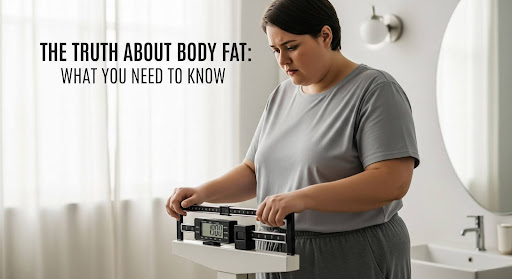
Body fat is often misunderstood. It’s easy to think of it solely as something to lose, but the truth about body fat is much more nuanced. It plays vital roles in energy storage, hormone production, and protecting internal organs. However, not all body fat is created equal, and understanding the differences can help you make healthier decisions for your fitness journey.
What Is Body Fat and Why Is It Important?
Body fat, also known as adipose tissue, is a type of connective tissue in the body that serves several important functions. It helps store energy, insulate the body, and protect vital organs. Fat also plays a critical role in regulating hormones and supporting cell structure. Although excess fat, especially visceral fat, can contribute to health issues, having an appropriate amount of body fat is essential for overall wellness.

Healthy Body Fat Percentages
Maintaining a healthy body fat percentage is crucial for overall health. Healthy body fat percentages vary based on age and gender. Generally, women have a higher healthy body fat range compared to men due to physiological differences.
| Age Group | Men (%) | Women (%) |
| 20–39 | 8–19 | 21–32 |
| 40–59 | 11–21 | 23–33 |
| 60–79 | 13–24 | 24–35 |
As you can see, the healthy body fat range increases with age for both genders. Maintaining a body fat percentage within the healthy range is key to supporting your body’s natural functions.
The Different Types of Body Fat

Not all body fat is the same. Here’s a look at the different types and how they affect your body:
1. Essential Fat
Essential fat is the minimum amount needed for basic bodily functions. This type of fat is found in vital areas like the brain, bone marrow, and organs. It’s necessary for survival and reproductive health. Essential fat makes up a small percentage of total body weight—3-5% in men and 8-12% in women.
2. Subcutaneous Fat
Subcutaneous fat is the fat stored directly under your skin. While excess subcutaneous fat can contribute to weight gain, it’s generally less harmful than visceral fat. This fat acts as a cushion for the body, helping to protect muscles and bones, and provides an energy reservoir.
3. Visceral Fat
Visceral fat is the fat stored deeper in the abdominal cavity, surrounding your internal organs. This type of fat is more dangerous as it’s linked to several chronic conditions such as heart disease, diabetes, and metabolic syndrome. It’s metabolically active and can impact hormone regulation and insulin sensitivity.
4. Brown and Beige Fat
Unlike white fat, which stores energy, brown and beige fat help the body burn calories to generate heat. Brown fat is particularly active in infants but can also be found in small amounts in adults. Beige fat, a type of white fat, has the potential to transform into brown fat under certain conditions, like cold exposure.
Also Read : Mini-Cut Secret: Fast Fat Loss Tool
Causes of High Body Fat
Excess body fat can stem from a variety of factors, both genetic and lifestyle-related. Understanding these causes can help you make informed decisions when it comes to managing your body fat.
1. Lifestyle
Poor eating habits, lack of physical activity, insufficient sleep, and high stress levels are major contributors to excess body fat. A diet high in processed foods, sugary drinks, and unhealthy fats leads to weight gain and increased fat storage, especially in the abdominal area.
2. Genetics
Some people are genetically predisposed to store more fat, particularly in certain areas of the body, such as the abdomen. If your parents had a higher body fat percentage, you might be more likely to carry extra weight in similar areas.
3. Medical Conditions
Certain medical conditions can affect how the body stores and utilizes fat. Hypothyroidism, polycystic ovary syndrome (PCOS), and Cushing’s syndrome are examples of conditions that can lead to higher body fat levels. These conditions affect hormone regulation, making it harder to lose weight or maintain a healthy fat percentage.
4. Medications
Certain medications can lead to weight gain, contributing to higher body fat levels. Medications such as antidepressants, steroids, and insulin or other diabetes medications can cause the body to store more fat.
5. Environmental and Social Factors
Environmental factors, such as lack of access to healthy food options and safe places to exercise, can also play a role in body fat accumulation. Social norms and stress from work, family, and social pressures can further exacerbate this issue.

Reducing Body Fat Healthily
Reducing body fat in a healthy, sustainable way requires a balanced approach. Fad diets and extreme measures often lead to temporary results and can be harmful in the long run. Instead, focus on these fundamental lifestyle changes:
1. Balanced Diet
Adopt a nutrient-dense diet that prioritizes whole foods such as fruits, vegetables, whole grains, and lean proteins. Limit processed foods, sugary drinks, and saturated fats. A balanced diet supports fat loss while nourishing the body with the necessary vitamins and minerals.
2. Regular Exercise
Incorporate both cardiovascular exercise (like jogging, cycling, or swimming) and strength training (to build muscle) into your routine. Regular physical activity helps burn calories, boost metabolism, and support fat loss while maintaining muscle mass.
3. Adequate Sleep
Quality sleep is crucial for regulating the hormones that affect hunger and fat storage. Aim for 7-9 hours of sleep per night to promote fat loss and overall health.
4. Stress Management
Chronic stress can lead to fat accumulation, especially in the abdominal region, due to the hormone cortisol. Practice stress-relieving activities like yoga, meditation, or deep breathing to help manage cortisol levels and reduce fat storage.
5. Consult with a Healthcare Professional
If you’re struggling to lose body fat or are concerned about your fat levels, it’s essential to speak with a doctor or registered dietitian. They can provide personalized advice and guidance tailored to your unique needs.

Frequently Asked Questions
-
Can I target fat loss in specific areas?
No, spot reduction is a myth. Fat loss occurs throughout the body as a whole. You can’t target fat loss in specific areas. A combination of overall fat loss through diet and exercise will eventually lead to fat reduction in problem areas.
-
What are the risks of excess visceral fat?
Excess visceral fat is linked to higher risks of heart disease, diabetes, and metabolic syndrome. It’s more dangerous than subcutaneous fat because it surrounds your internal organs and can interfere with your metabolic processes.
-
How can I maintain a healthy body fat percentage?
Maintaining a healthy body fat percentage requires regular exercise, a balanced diet, adequate sleep, and stress management. Avoid crash diets and focus on long-term, sustainable changes that support overall health.
-
Is it possible to have a high body fat percentage and still be fit?
Yes, it’s possible. Fitness is not solely determined by body fat percentage. Many fit individuals carry a higher percentage of body fat but still maintain good muscle mass and cardiovascular health. Focus on strength and fitness rather than just fat loss.
Conclusion: The Truth About Body Fat
The truth about body fat is that it’s not just something to lose. Fat serves several critical functions in the body, from energy storage to hormone regulation and organ protection. The key to managing body fat is balance—maintaining a healthy body fat percentage that supports your health and fitness goals.
Adopting a balanced diet, regular exercise routine, adequate sleep, and effective stress management can help you maintain a healthy body fat level. Focus on sustainable habits rather than quick fixes, and remember, fat loss should be approached in a way that supports your overall well-being.


